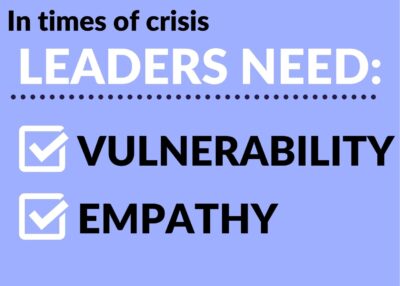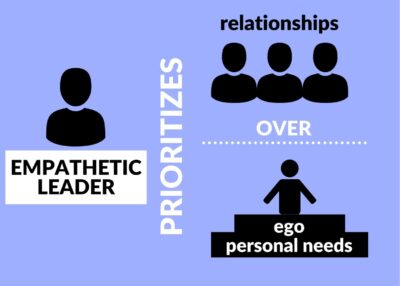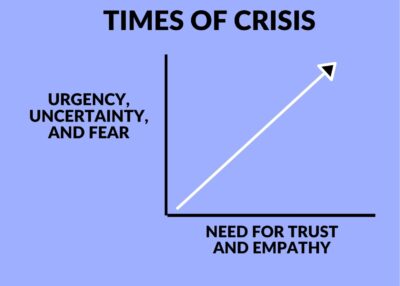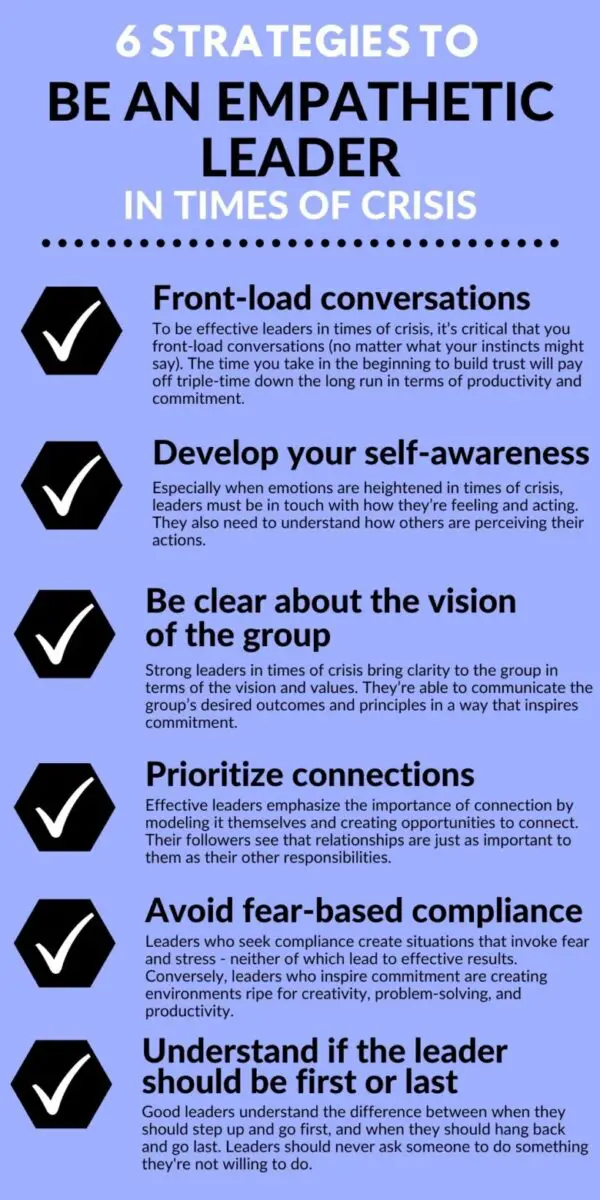Why We Need Empathetic Leadership and Vulnerability in Times of Crisis
What do you think of when you envision a leader? Over recent decades, our leadership definition has shifted away from authoritarian figures who instill fear in their followers. Our society has begun to realize (and study) the importance of vulnerability in leadership. However, we often default back to our old notions of leadership in times of crisis.
Not only does this hurt our effectiveness, but it puts us at risk for greater harm than good.
We’re living in times of crisis. With the global pandemic and skyrocketing case of COVID-19, we are experiencing a critical time of uncertainty and fear. Now, more than ever, we’re looking to our leaders for direction and guidance.
What should leaders do in times of crisis?
Instead of demanding compliance, leadership in crisis needs to earn it through trust. Rather than forcing results, leaders must inspire commitment and investment.
If it sounds like a tall task, it is. But it’s not impossible. In fact, by focusing on two crucial practices, leaders can achieve the results they want. In times of crisis, leaders must emphasize vulnerability and empathety.
How do we do this when our natural tendency is to turn away from vulnerability and empathetic leadership?
Daryl Black, a leadership coach with years of crisis leadership experience under his belt, helps teach us how.

.
Empathetic Leadership in Crisis with Daryl Black
Daryl Black stepped into his first leadership role at age 20 for a local group of emergency first responders. Initially, in an attempt to prove himself, he set high expectations, barked orders, and tried to control the group’s behaviors. After all, the pressure was extremely high. Their rescue operations were literally life-or-death scenarios.
Over the years, he began to realize this approach, while effective, could be made even stronger. There was still room for his rescue group to come together with even more cohesion and positive results.
Thirty years later, Daryl recognizes that his well-intentioned first attempt at leadership could’ve been more empathetic. He put himself in front of the group when he should have put himself at the back.
.
Leaders Should Put Empathy First: A Look at Empathetic Leadership
Empathy-first leadership means putting connections above all else. Empathetic leaders understand the importance of getting to know the people they’re leading as people, not merely by their job descriptions.
This mindset entails stepping back – and putting your ego aside – to listen to others’ needs and wants. Not only do you display empathy, but you also develop your consciousness of the situation at hand.
In empathetic leadership, the end goals for the leader don’t have to change. Instead, these leaders do a better job communicating these goals to their followers and helping everyone see their importance. Then, they help facilitate the work toward these goals.
Daryl Black refers to this facilitation as “social influence.” The more connected you are with the people you’re working with, the more you can help move them toward the desired outcome.
Daryl also makes sure to explain the distinction between this social influence and manipulation. Leaders aren’t acting as puppet masters who control their followers. Quite the contrary, their followers are actively choosing to work toward the shared outcome.

.
Why Vulnerability and Empathy in Leadership are So Crucial In Times of Crisis
A crisis heightens emotions and amplifies the sense of urgency. This often creates a stressful environment that taps into our innate fight-or-flight instincts. Our increased fear makes us less likely to listen and trust others around us.
Unfortunately, this lack of trust is the exact opposite of what we need when in times of crisis. To fight back the urge for distrust and uncertainty, leaders must build trust quickly and intentionally.
This trust-building doesn’t need to come in the form of week-long retreats and team-building activities. Leaders can build trust in their very first interactions by being vulnerable. By modeling vulnerability, they demonstrate how important authenticity and connection are to the group.
Remember, it’s hard to be vulnerable (in part because our culture has created so many myths around vulnerability). Keep in mind that anytime you allow others to see your true self – your values, fears, strengths, weakness, etc. – you are practicing vulnerability and empathy-first leadership.

.
How to Model Vulnerability in the First Conversation (Empathetic Leadership)
Daryl has spent over thirty years leading first responders in times of crisis. His experiences have brought him all over the country, including rescue missions for several large-scale disasters. With each new rescue situation, he’s faced with the same dilemma: How do I lead a group of people through a high-stakes operation?
To make matters more stressful, Daryl often doesn’t have weeks or months to earn his followers’ trust and respect. He has hours (and sometimes minutes).
To overcome these hurdles, Daryl starts every interaction by connecting with the people he’s working with. Whether it’s a quick conversation or a lengthy discussion, Daryl’s learned that this connection will hugely benefit the group. He understands that delaying expectations and rules – even for a few minutes – will pay off tremendously in the long run.
Daryl also leads by sharing his own vulnerabilities in these conversations. He’s not afraid to show his true self, even if it might make him look imperfect. This willingness to be imperfect is an example of empathy-first leadership.
“Vulnerability leads to trust, and trust is the glue that effective groups need to build commitment,” Daryl says. “This is the difference between compliance and commitment. You want people invested in the work they’re doing.”
Leaders in crisis must value empathy by listening. Empathy-first leadership must prioritize vulnerability by modeling it.
.
How Leaders Can Build Empathetic Leadership and Commitment in Times of Crisis
Here are six strategies to help build commitment in times of crisis and develop empathy-first leadership.

1. Front-load conversations
Leaders generally push the “get to know you” conversations to the end of the to-do list. After all, it isn’t easy to prioritize team bonding when so many more deadlines face us. Too often, we don’t get to these conversations at all. To be effective leaders in times of crisis, it’s critical that you front-load conversations (no matter what your instincts might say). The time you take in the beginning to build trust will pay off triple-time down the long run in terms of productivity and commitment.
2. Develop your self-awareness
Research proves that self-awareness leads to success and effectiveness, and leadership is no different. Especially when emotions are heightened in times of crisis, leaders must be in touch with how they’re feeling and acting. They also need to understand how others are perceiving their actions. Many of us falsely assume we’re self-aware (90% of people think they’re self-aware when less than 10% actually are). The sooner we can develop our self-awareness, the sooner we can be the most effective leaders we need to be.
3. Be clear about the vision of the group
We all need to understand what we’re working toward to be fully invested. Furthermore, a lack of understanding can create uncertainty and confusion. Strong leaders in times of crisis bring clarity to the group in terms of the vision and values. They’re able to communicate the group’s desired outcomes and principles in a way that inspires commitment. Empathy-first leadership is not telling, but talking.
4. Prioritize connections
Human beings, by nature, are tribal. We latch onto differences and are quick to jump to an “us vs. them” mentality. However, once we find similarities and common ground, we’re just as easily swayed to work together. Effective leaders emphasize the importance of connection by modeling it themselves and creating opportunities to connect. Their followers see that relationships are just as important to them as their other responsibilities.
5. Avoid fear-based compliance
The distinction between compliance and commitment is a critical one. Leaders who seek compliance create situations that invoke fear and stress – neither of which lead to effective results. Conversely, leaders who inspire commitment are creating environments ripe for creativity, problem-solving, and productivity.
6. Understand if the leader should be first or last
It’s overly simplistic to put the leaders first or last universally. Instead, good leaders understand the difference between when they should step up and go first, and when they should hang back and go last. For example, a leader should be first to take ownership, but last to take the credit or reward. Furthermore, leaders should never ask someone to do something they’re not willing to do.
.
Why Vulnerability in Leadership is a Strength in Times of crisis
According to Daryl Black, people decide to follow a leader. While organizational hierarchies might denote a leader-follower relationship, it is an active choice for the follower to fully commit to their leader.
In a crisis, vulnerable and empathetic leaders will be much more successful at earning this respect and trust. Ultimately, this trust will help ground the group (and fight against the natural pull toward fear, chaos, and uncertainty).
[/fusion_text][fusion_text columns=”” column_min_width=”” column_spacing=”” rule_style=”default” rule_size=”” rule_color=”” content_alignment_medium=”” content_alignment_small=”” content_alignment=”” hide_on_mobile=”small-visibility,medium-visibility,large-visibility” sticky_display=”normal,sticky” class=”” id=”” font_size=”” fusion_font_family_text_font=”” fusion_font_variant_text_font=”” line_height=”” letter_spacing=”” text_color=”” animation_type=”” animation_direction=”left” animation_speed=”0.3″ animation_offset=””]
.
Conclusion: The Importance of Empathetic Leadership
Our society has slowly evolved away from our outdated model of authoritarian leadership. However, we still have work to do – especially in times of crisis.
Leaders need to put empathy and vulnerability first to be successful. By prioritizing connection and leading with empathy, leaders can inspire commitment, ease fears, and build trust – three essential elements for effective groups.
Daryl Black offers six strategies to help build commitment in times of crisis and prioritize empathy-first leadership:
- Front-load conversations
- Develop your self-awareness
- Be clear about the vision of the group
- Prioritize connections
- Avoid fear-based compliance
- Understand if the leader should be first or last
Ultimately, vulnerability is a strength for leaders in times of crisis. Want to be a more vulnerable leader? Learn how to be more vulnerable and why developing your self-awareness should be your first step.
.
About Daryl Black
Daryl Black is a leadership coach, author, and speaker with more than 30 years of senior crisis leadership experience. He’s worked with countless executives, business owners, and managers to help transform their leadership skills and mindset to become more effective in their line of work. You can learn more about Daryl on his website or listen to his podcast Lead From the Inside Out. He also runs a leadership academy that you won’t want to miss.





You completed some fine points there. I did a search on the subject matter and found nearly all folks will go along with with your blog. Cristina Hall Sully